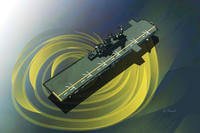ANNAPOLIS, Md. -- When the most recent fighter rotation of the Marine Corps unit deployment program departed for the Pacific several weeks ago, it brought with it a full complement of 12 F/A-18 Hornets, in contrast to the reduced 10-plane squadron that preceded it.
This small development is a sign of the service's growing confidence in the readiness of its aging fighters, said Lt. Gen. Robert Hedelund, commanding general of II Marine Expeditionary Force.
Speaking at the National Defense Industrial Association's Expeditionary Warfare Conference on Tuesday, Hedelund said the decision to deploy 12 aircraft from the Beaufort, South Carolina-based Marine Fighter Attack Squadron 251 to Japan was thanks to an aggressive effort from Marine Aircraft Group 31 to get the planes ready to depart.
"We had been at a 10-plane deployment due to readiness concerns, and the thought was, 'We may not be around the corner yet, but we're seeing the corner,' " he said. "So let's see if we can go back to a 12-plane deployment."
The service's Hornets, which will begin to retire in coming years, have suffered amid high operational demands and limited maintenance funds. Earlier this year, reports surfaced that only about a third of the aircraft were immediately able to fly, with the majority stuck on the flightline due to spare part or maintenance concerns.
At least one recent crash -- a collision of two Hornets over the Pacific in November 2016 -- was found to have been caused in part by reduced pilot flight hours, a side effect of the reduction in available aircraft to fly.
In a July interview with Military.com ahead of his retirement, the Corps' then-head of aviation, Lt. Gen. Jon "Dog" Davis, said average monthly flight hours were beginning to improve across the force, though Hornets remained slightly below the target.
"And that won't get better until the inventory numbers get better in F-18, and the reliability gets better with the old airplanes," he said. "Right now, we have a pretty high break rate on the legacy F-18."
He added that the Marine Corps and Navy had commissioned an independent readiness review on the F/A-18, and that the Corps had set in motion measures to retire Hornets several years ahead of schedule in favor of the new F-35B Joint Strike Fighter.
Hedelund said he is seeing some improvements at the squadron level, where pilots are getting more time with their aircraft prior to deployment, a key requirement for full preparedness.
"When I was a [Marine Aircraft Wing] commander, I used to say we deployed F/A-18s while the paint was drying. Because we literally would get the airplanes, we'd put the pilots in them, and send them on their next deployment," he said. " ... Those days are gone, thankfully."
Hedelund commanded 2nd MAW on the East Coast, from 2013 to 2015.
When VMFA-251 deployed to Japan, he said, the transit across the Pacific went smoothly, without any mechanical issues or aircraft left on the runway.
"[It's] having a little bit more money that aviation always works very, very hard to put into the readiness accounts, the parts, the materials, all the things they have to start literally from aluminum to get to the flightline," he said. "We're not declaring victory, and we're not dancing in the end zone, but we're having an impact, I think, where we can."










